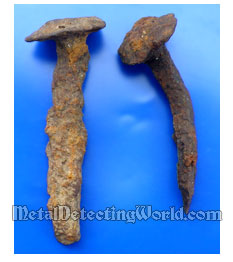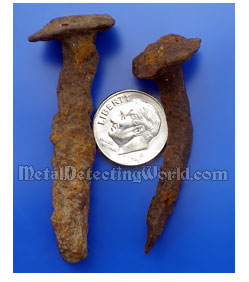XP Deus Program Settings, Features and Modes Explained, page 10
Examples of REACTIVITY Effectiveness
(...CONTINUED from Previous Page)
Here are good examples of how the Deus' reactivity works in a common case of a coin being surrounded by iron nails. I implemented the 18kHz operational frequency while running the following tests.
If you scan two rusty hand-wrought square nails, ca. 16th century, with a stock 9-inch search coil, you would hear a low-grunting response. The nails may sound off with a "broken" high-pitched tone in addition to "iron buzz" if you change the coil's sweep direction and "catch" surfaces of both nail heads.

Two Hand-Wrought Square Nails
To Be Used in Testing Reactivity Settings
For the first test, I used a high-conductive US Dime (10-Cent coin of 18mm in diameter) which I placed right in between the nails as shown on a picture below. I set the Reactivity level at 3, the Silencer level at 2, the Iron Volume at 3, the Detection Frequency at 18 kHz and the Sensitivity level at 92.

US Dime Is Placed
Between Two Nails
First I swept the search coil in a North-South direction, and the Deus gave a broken, inconsistent response to a coin. When I did 90° on the coin and isolated the Deus' response to it, to my surprise, the Deus gave a clear, both ways, high-pitched response to the Dime, and no iron buzzing accompanied the response!
While sweeping the coil in the West-East direction, I lowered the Reactivity level to 2 and achieved the same result; the rest of settings remaining unchanged. The Dime's VDI read-outs were bouncing between 82 and 94. When I lowered the Reactivity level to 1, the response was "clipped" the same way as when I swept the coil in the N-S direction, and the iron buzz appeared - all reflecting a usual reaction of common metal detectors whose Reactivity is factory-preset at 1.
Testing a low-conductive US Nickel (5-Cent coin of 21mm in diameter) in the same manner as before and with the Reactivity level being set at 2 resulted in a response that was even better sounding than the response to the Dime.

US Nickel Is Placed
Between Same Two Nails
The Nickel's VDI read-outs were bouncing between 40 and 46 - not much. These tests proved that the quality of the Deus' response to the nail-masked coin depends on the coin's SIZE and not the coin's conductive properties. Of course, under real search conditions when the nails are surrounded with long-built Halo Effects, isolating the audio responses to the nail-masked coins is more challenging than during the air testing. However, the Reactivity effects manifest themselves all the time; thus, making the Deus' Reactivity a powerful tool for unmasking valuable targets.
As for a sweep speed of the Deus' search coil, do not think that if you set the Reactivity high, you could cover a farm field with a speed of 100 mph and get good results. Even though the user manual states that "higher reactivity levels (3, 4, 5) enable the detector to tolerate fast sweeps better.", it can only be possible if one searches for large-sized (like a dollar or a "piece of eight"), unmasked coins. The Deus' responses to all tiny or small and partially masked coins will NOT be heard, and the coins will be easily passed up if a high sweep speed is used!
I do not mean that you should slow the coil's sweep speed to a crawl which is just another extreme. Just do not sweep the coil too fast so that you could hear all "details" of an audio "picture" of the ground under your feet. It means LISTEN carefully to the Deus' responses to targets!
And then, as you notice (receive) an 'interesting' (complex but promising) response to a target, you have to use the Deus' search coil wiggling technique (described on page 2 in Part II) in order to isolate the "good" response from a "bad" signal and correctly pinpoint it.
If you have just entered the hobby of metal detecting, you may want to read my article on Search Coils and Search Coil Discipline to learn the basics of how to sweep the coil properly.
<